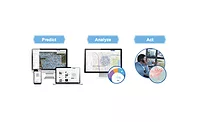Analyze This

Craig Chambers is CEO and president of Cernium Corporation. He’s on a mission to help chief security officers see what they are missing. Cernium specializes in video analytics and behavioral recognition software for physical security. The concept of video analytics is layered into security systems to dissect video from cameras, identify potential threats and alert operators in real-time.
Security Magazine: What’s the role of advanced video analytics in today’s security operation?
Chambers: Advanced video analytics are the latest evolution in surveillance monitoring and serve as a critical component of a security operation. Without this capability, companies lack the ability to effectively monitor video from security cameras on a 24/7 basis. Advanced analytics apply behavioral recognition technology to identify potential security violations, such as an individual loitering in an unmanned pedestrian area late at night.
The software then makes a forensic video record of that event and transmits an alert to security personnel via an audio or visual notification, e-mail or wireless text message. It essentially removes the elements of human inattention, fatigue and error to provide nonstop video surveillance on a real-time basis. Analytics are better than the human equivalent, perpetually attentive and able to monitor multiple feeds non-stop without error. This allows security forces to be more flexibly deployed in secure areas, with more situational awareness, rather than sitting behind banks of monitors. It also ensures the video from security cameras is actually being watched and acted on.
Security Magazine: What are the added business benefits by employing a video analytics program in a given facility?
Chambers: As with any enhanced security application, companies using a video analytics platform will see a measurable increase in security personnel response time to incidents and a decrease in missed incidents. With forensic capabilities, security forces are given an added value to their monitoring and response arsenal. Additionally, less security personnel will be required and those that remain will be liberated from the monotony of sitting in front of monitors.
The behavioral recognition feature of a video analytics solution alone is a huge benefit to any business that has security concerns. In addition to alerting security personnel to erratically moving or lurking persons, the interface is highly customizable, which means that virtually any behavioral pattern can be monitored for. Multiple criteria can be predetermined and identified in tandem. Even subtle behaviors easily missed by security personnel, such as left packages or removal of items such as laptops, are quickly picked up by video analytics, triggering alerts and alarms.
Security Magazine: With more solutions available today, what are key considerations buyers should be aware of?
Chambers: Video analytics solutions must match the complexity of real world security scenarios – different situations occur at different times and threat scenarios change frequently and dramatically. It doesn''t matter how many “events” a solution can detect if it can''t detect the specific combinations a customerneeds during the specific time periods they define. Basic motion detection or solutions that detect only one or two events do not fully reflect the reality of today’s security requirements and will have to be augmented in the overall security architecture. The comprehensiveness of the solution to meet complex requirements, the ease of customization and full-in cost to deploy a solution are important considerations.
Security Magazine: What future developments do you foresee in the video analytics industry?
Chambers: Video analytics will become a core element of security operations that use security cameras. However, the analytics industry will segment into lower tier solutions that offer basic capabilities ideal for stand-alone installations with fewer cameras and advanced solutions that address the complex needs of larger organizations in practical, efficient ways. Already, analytics have moved from “boxes drawn around objects” to dynamic, autonomous programs to enhance security programs. The future holds a more ubiquitous place for analytics. Organizations will be hard-pressed to not have an analytics solution incorporated in their security program.
Looking for a reprint of this article?
From high-res PDFs to custom plaques, order your copy today!





